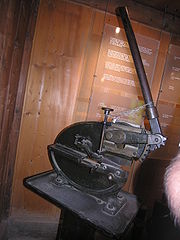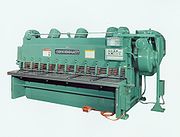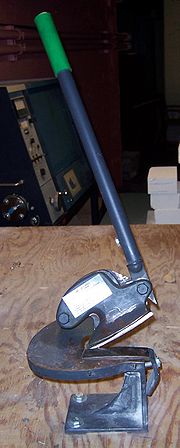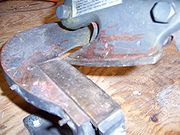
Shear (sheet metal)
Encyclopedia
Bench shear

Workbench
A workbench is sturdy table at which manual work is done. They range from simple flat surfaces to very complex designs that may be considered tools in themselves. Workbenches vary in size from tiny jewelers benches to the huge benches used by staircase makers...
mounted shear with a compound mechanism to increase the mechanical advantage. It is usually used for cutting rough shapes out of medium sized pieces of sheet metal, but cannot do delicate work. For the small shear, it mostly designed for a wide field of applications. Light weight and easy efficient operation, yet very sturdy in construction. The cutting blades fitted are carefully and accurately ground to give easy, clean quick cuts, and free of burrs. These special features help the operators save a great deal of their energy. But some shearing machine can cut sheet bar and flat bar up to 10mm. It is electrically welded together to make it a sturdy stable unit capable to withstand highest stresses due to heavy duty usage. The footplates are reinforced with bracing angles so that they give firm stability to the shear. The machine is provided with section knives with sliding blades which can be adjusted by hand to make 90 cuts on angels and T-sections of different sizes as well as with openings for cutting round and square bars.
Guillotine

Rake angle
Rake angle is a parameter used in various cutting and machining processes, describing the angle of the cutting face relative to the work. There are three types of rake angles: positive, negative, and zero...
, to keep the material from becoming wedged between the blades, however it compromises the squareness of the edge. As far as equipment is concerned, the machine consists of a shear table, work-holding device, upper and lower blades, and a gauging device. The shear table is the part of the machinery that the workpiece rests on while being sheared. The work-holding device is used to hold the workpiece in place and keep it from moving or buckling while under stress. The upper and lower blades are the piece of machinery that actually do the cutting, while the gauging device is used to ensure that the workpiece is being cut where it is supposed to be.
The design of press
Machine press
A machine press, commonly shortened to press, is a machine tool that changes the shape of a workpiece.-Servomechanism:A servomechanism press, also known as a servo press or a electro press, is a press driven by an AC servo motor. The torque produced is converted to a linear force via a ball screw....
tools is an engineering compromise. A sharp edge, strength and durability are ideal, however a sharp edge is not very strong or durable so blades for metal work
Metalworking
Metalworking is the process of working with metals to create individual parts, assemblies, or large scale structures. The term covers a wide range of work from large ships and bridges to precise engine parts and delicate jewelry. It therefore includes a correspondingly wide range of skills,...
tend to be square-edged rather than knife-edged. Typical workpiece materials include aluminum, brass, bronze, and mild steel because of their outstanding shearability ratings, however, stainless steel
Stainless steel
In metallurgy, stainless steel, also known as inox steel or inox from French "inoxydable", is defined as a steel alloy with a minimum of 10.5 or 11% chromium content by mass....
is not used as much due to its tendencies to work-harden.
Other types of geometrical possibilities include the squaring shear, angle shear, bow-tie shear and bar shear. All of these have many different uses and are all used regularly in certain manufacturing fields.
Power shears
A power shear is electrically or pneumatically powered hand toolHand tool
A hand tool is a device for performing work on a material or a physical system using only hands. The hand tools can be manually used employing force, or electrically powered, using electrical current...
designed to blank
Blanking (metalworking)
Blanking and piercing are shearing processes in which a punch and die are used to modify webs. The tooling and processes are the same between the two, only the terminology is different: in blanking the punched out piece is used and called a blank; in piercing the punched out piece is...
large pieces of sheet metal. They are designed to cut straight lines and relatively large radius curves. They are advantageous over a bandsaw because there is not a size limit. Large versions can cut sheet metal up to 12 gauge.
Throatless shear


Tool
A tool is a device that can be used to produce an item or achieve a task, but that is not consumed in the process. Informally the word is also used to describe a procedure or process with a specific purpose. Tools that are used in particular fields or activities may have different designations such...
used to make complex straight and curved cuts in sheet metal
Sheet metal
Sheet metal is simply metal formed into thin and flat pieces. It is one of the fundamental forms used in metalworking, and can be cut and bent into a variety of different shapes. Countless everyday objects are constructed of the material...
. The throatless shear takes its name from the fact that the metal can be freely moved around the cutting blade (it does not have a throat down which metal must be fed), allowing great flexibility in shapes that can be cut.

